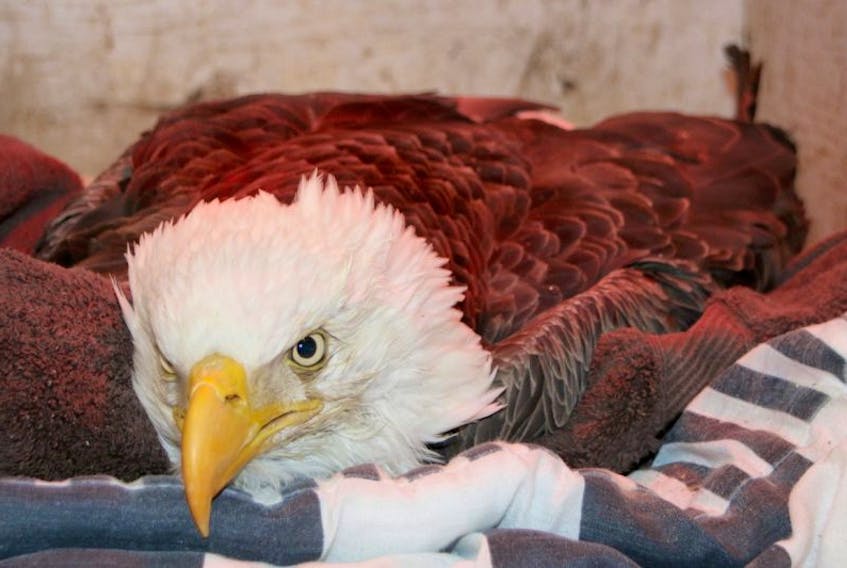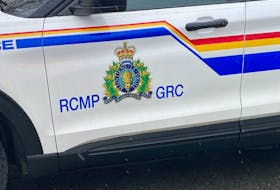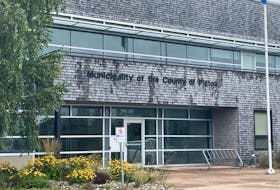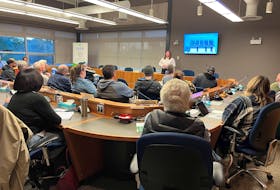The third lead-poisoned eagle of the season arrived at the Cobequid Wildlife Rehabilitation Centre (CWRC) Wednesday. By Thursday afternoon it had died, despite VanDoninck’s efforts.
“The levels tested really high,” said VanDoninck, the veterinarian who runs the centre. “We haven’t yet saved one with levels that high.”
Because lead affects the nervous system, the bird, found in the Bridgewater-Liverpool area, had not been able to fly to find food for a while and was thin. Because he was grounded he was also infested with lice.
RELATED: Christmas eagle dies from lead poisoning
RELATED: Road to recovery: Lead-poisoned eagle being cared for at Hilden wildlife centre
Birds ingest lead when eating the remains of animals shot with lead ammunition, or from swallowing lead tackle or eating fish that have swallowed it. It affects a bird's nervous system and can cause seizures, blindness, paralysis, and difficulty eating and breathing.
The eagles aren’t the only raptors to arrive with lead poisoning this year. A red tailed hawk, caught in a snare, was also suffering from lead poisoning, although he died from the injuries caused by the snare. A black vulture tested positive for low levels of lead and is recovering at the CWRC.
There is one simple thing people can do to prevent birds from being poisoned with lead, and that is to switch to non-lead ammunition and tackle.
“More people are using copper now but the majority is still lead,” said VanDoninck. “There’s a long road ahead of us. I think what we’re seeing is the tip of the iceberg and most of the poisoned birds are never found.”
Lead is a toxic heavy metal and when bullets hit an animal they fragment into hundreds of pieces, some so small they cannot be seen by the naked eye. Because they spread up to 45 centimetres (18 inches), people who eat game meat may also be ingesting tiny lead particles.
Every gut pile or remnant of an animal shot with lead ammunition is a pile of poison and VanDoninck asks that people leave nothing behind in the woods.
VanDoninck provides presentations on the dangers of lead and exchanges lead for non-lead ammunition and tackle whenever possible. She is currently looking for more funding to purchase non-lead ammunition and tackle for exchanges.
The third lead-poisoned eagle of the season arrived at the Cobequid Wildlife Rehabilitation Centre (CWRC) Wednesday. By Thursday afternoon it had died, despite VanDoninck’s efforts.
“The levels tested really high,” said VanDoninck, the veterinarian who runs the centre. “We haven’t yet saved one with levels that high.”
Because lead affects the nervous system, the bird, found in the Bridgewater-Liverpool area, had not been able to fly to find food for a while and was thin. Because he was grounded he was also infested with lice.
RELATED: Christmas eagle dies from lead poisoning
RELATED: Road to recovery: Lead-poisoned eagle being cared for at Hilden wildlife centre
Birds ingest lead when eating the remains of animals shot with lead ammunition, or from swallowing lead tackle or eating fish that have swallowed it. It affects a bird's nervous system and can cause seizures, blindness, paralysis, and difficulty eating and breathing.
The eagles aren’t the only raptors to arrive with lead poisoning this year. A red tailed hawk, caught in a snare, was also suffering from lead poisoning, although he died from the injuries caused by the snare. A black vulture tested positive for low levels of lead and is recovering at the CWRC.
There is one simple thing people can do to prevent birds from being poisoned with lead, and that is to switch to non-lead ammunition and tackle.
“More people are using copper now but the majority is still lead,” said VanDoninck. “There’s a long road ahead of us. I think what we’re seeing is the tip of the iceberg and most of the poisoned birds are never found.”
Lead is a toxic heavy metal and when bullets hit an animal they fragment into hundreds of pieces, some so small they cannot be seen by the naked eye. Because they spread up to 45 centimetres (18 inches), people who eat game meat may also be ingesting tiny lead particles.
Every gut pile or remnant of an animal shot with lead ammunition is a pile of poison and VanDoninck asks that people leave nothing behind in the woods.
VanDoninck provides presentations on the dangers of lead and exchanges lead for non-lead ammunition and tackle whenever possible. She is currently looking for more funding to purchase non-lead ammunition and tackle for exchanges.









